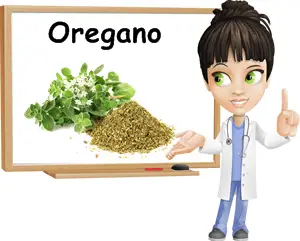Often called wild marjoram, oregano (Origanum vulgare) is a culinary herb from the mint family with a complex flavor and several great medicinal properties. The plant and its derivate essential oil obtained from their aerial parts are both generous sources of polyphenolic flavones as well as specific volatile oil constituents such as monoterpenes and monoterpenoids.
Carvacrol, a polyphenol found in generous amounts in oregano, savory, marjoram, dill and their essential oils has been shown to possess quite impressive anticancer and antimicrobial properties.
What does oregano look like?
Oregano has spade-like leaves of a distinctive olive green color, fuzzy green stems and tiny, purple flowers. Although it looks somewhat like marjoram and is even called wild marjoram, oregano is a completely different herb. The plant grows to about 20-80 cm in height and prefers warmer climates and lots of sun.

What does oregano taste and smell like?
Generally, oregano has a mild, bitter-sweet and warm, spicy flavor combination and gives off a pleasant aroma. The varieties grown mostly throughout the Mediterranean have a softer taste than the popular and spicier Mexican oregano.
Depending on the variety and cultivar, oregano may be more or less tangy, spicy, sweet or aromatic. Another very important aspect to consider when cooking with it is that fresh leaves have considerably less flavor than dried ones, so make sure you follow recipe indications in this respect.
What is oregano good for?
The medicinal properties of oregano are not the main focus when it comes to the herb and its uses. Nevertheless, if you prefer oregano to other spices and herbs and consume it regularly, then know that it boasts several reliable health effects, not to mention it is a source of important essential nutrients.
Here is a list of the top 5 properties and health benefits of oregano:
1) Exhibits antimicrobial properties.
According to research, oregano essential oil can successfully inhibit Yersinia enterocolitica, Listeria monocytogenes, Escherichia coli, Pseudomonas aeruginosa as well as norovirus growth. Infection with these pathogens can cause enterocolitis, small intestine inflammation, listeriosis with septicemia, pneumonia and meningitis, various mild to severe blood, urinary and respiratory tract infections. (source)

The constituents in oregano responsible for the antibacterial and antiviral inhibitory and anti-inflammatory effects of the herb are believed to be carvacrol and thymol. Research: Antiviral efficacy and mechanisms of action of oregano essential oil and its primary component carvacrol against murine norovirus. The antibacterial activity of oregano essential oil (Origanum heracleoticum L.) against clinical strains of Escherichia coli and Pseudomonas aeruginosa.
2) Boasts anticancer activity.
Carvacrol, thymol, p-cymene, gallic acid, tannins, catechins and anthocyanins in oregano and oregano essential oil have been shown to exhibit both a potent cytotoxic activity against various types of cancer cells and a protective antioxidant effect on healthy cells.
While oregano essential oil in itself is safe for consumption (unless you are allergic to the herb or pregnant), its constituents can efficiently inhibit tumor growth and spread by means of a cytotoxic response.
3) Rich in polyphenolic compounds.
Preliminary studies have identified at least 46 bilogically active constituents in oregano, namely carvacrol, thymol, gallic acid, catechins, anthocyanin cyanidins, etc. Aside from anti-inflammatory, anticancer and antioxidant properties, these compounds in the herb exhibits antibacterial and even antimalarial activity (Oregano: chemical analysis and evaluation of its antimalarial, antioxidant, and cytotoxic activities).
4) Excellent source of vitamins and dietary minerals.
Dried oregano is a great source of important vitamins and minerals such as vitamins A, E, K, B6, B9, B2, calcium, iron, magnesium, potassium and zinc. For example, 100 g of the herb contains about 18 mg of vitamin E, 3 mg more than the recommended daily intake for an average adult.
While we will certainly not eat 100 g in a week, let alone in one sitting, including herbs and spices such as oregano in our diet is important because even the tiniest amounts can help add to our daily intake and prevent deficiencies.
Oregano nutrition facts
Here is a little comparison to help give you a better idea of the nutritional value of the herb:
(Vitamin E)
Daily requirements for an average adult: 15 mg
100 g of dried oregano: 18.26 mg
(Vitamin B6)
Daily requirements: 1.3 mg
100 g of dried oregano: 1.04 mg
(Vitamin B9, folate)
Daily requirements: 400 mcg
100 g of dried oregano: 237 mcg
(Calcium)
Daily requirements: 1000-1200 mg
100 g of dried oregano: 1597 mg
(Iron)
Daily requirements: 8-18 mg
100 g of dried oregano: 36.8 mg
(Magnesium)
Daily requirements: 320-420 mg
100 g of dried oregano: 270 mg
(Zinc)
Daily requirements: 9-11 mg
100 g of oregano: 2.96 mg.
(source)
Other potential uses Of Oregano
Traditional medicine recommends oregano essential oil and herbal infusions for external (wound healing, local antiseptic) and internal use (upset stomach, sore throat or other respiratory tract problems).
Nevertheless, these claims are not supported by medical evidence which is why you should consult your healthcare provider in all of the above-mentioned situations to correctly diagnose your condition and discuss treatment options.
Conclusion
The purported health benefits of the herb are a result of its essential oil constituents as well as vitamins and minerals, all of which work together towards attaining various health effects. However, oregano does not enjoy much fame due to poor research and the existence of far better choices to replace it. Nevertheless, if you enjoy this particular herb, know it too is a great culinary choice as a result of its nutrient, antioxidant and essential oil content.
